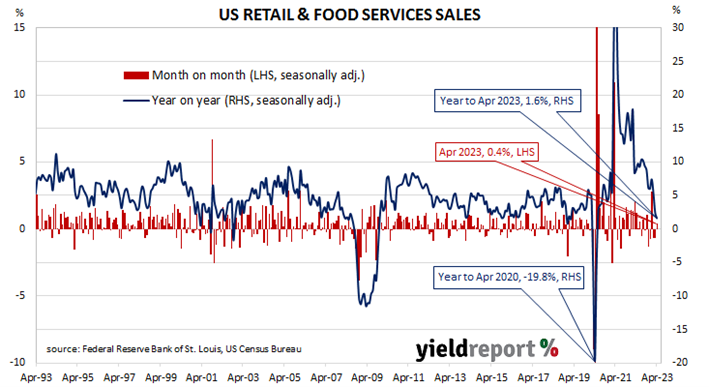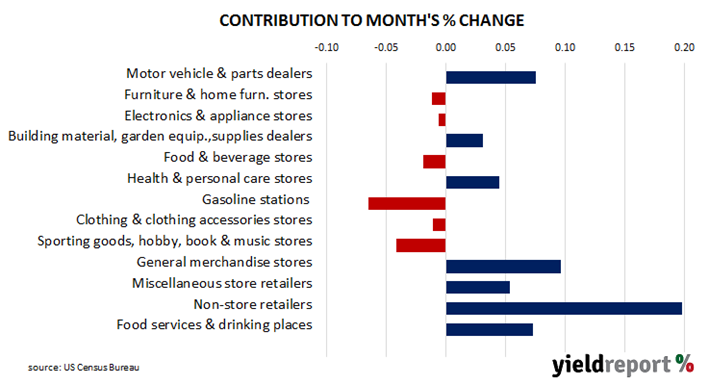Summary: US retail sales up 0.4% in April, less than expected; annual growth rate slows to 1.6%; ANZ: indicates brisk start to private consumption in June quarter; Treasury bond yields rise; rate-cut expectations soften; rises in seven of thirteen retail categories; non-store retailers segment largest single influence on month’s result.
US retail sales had been trending up since late 2015 but, commencing in late 2018, a series of weak or negative monthly results led to a drop-off in the annual growth rate below 2.0%. Growth rates then increased in trend terms through 2019 and into early 2020 until pandemic restrictions sent it into negative territory. A “v-shaped” recovery then took place which was followed by some short-term spikes as federal stimulus payments hit US households in the first and second quarters of 2021.
According to the latest “advance” numbers released by the US Census Bureau, total retail sales increased by 0.4% in April. The result was less than the 0.7% increase which had been generally expected but it was in contrast to March’s -0.7%. On an annual basis, the growth rate slowed from 2.4% to 1.6%.
“The data indicate a brisk start to private consumption for Q2 and will have a positive impact on early GDP estimates for this quarter,” said ANZ senior economist Adelaide Timbrell. “Retail sales account for around 35% of private consumption in the US and the rise in control group sales, which is used to calculate GDP, implied that demand is not yet slowing sufficiently to alleviate underlying inflation imbalances.”
The figures came out the same morning as the latest industrial production figures and US Treasury bond yields rose on the day, especially at the short end of the yield curve. By the close of business, the 2-year Treasury yield had gained 7bps to 4.07%, the 10-year yield had added 4bps to 3.54% while the 30-year yield finished 2bps higher at 3.86%.
In terms of US Fed policy, expectations of a lower federal funds rate through the remainder of 2023 and into 2024 softened a little. At the close of business, contracts implied the effective federal funds rate would average 5.095% in June, essentially unchanged from the current spot rate, and then creep up a touch to an average of 5.105% in July. September futures contracts implied a 5.005% average effective federal funds rate while May 2024 contracts implied 3.75%, 133bps less than the current rate.
Seven of the thirteen categories recorded higher sales over the month. The “Non-store retailers” segment provided the largest single influence on the overall result, rising by 1.2% over the month and contributing around 0.20 percentage points.
The non-store segment includes vending machine sales, door-to-door sales and mail-order sales but nowadays this segment has become dominated by online sales. It now accounts for over 16% of all US retail sales and it is the second-largest segment after vehicles and parts.



